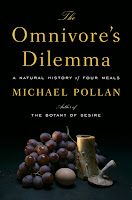
Michael Pollan, author of
The Omnivore's Dilemma and Knight Professor of Science and Environmental Journalism at UC Berkeley spoke to the Berkeley Community on Wednesday evening about the “omnivore’s solution.” Pollan asks, “ What do we know about the links between what we eat and our own health? You can’t have a healthy diet without a healthy agriculture.” The problem is that when it comes to choosing what to eat, he says, “we are lost.”
Pollan began by unloading a few plastic Safeway bags of goodies that included Twinkies, Froot Loops, nutrition bars, and whole wheat Wonder Bread; products he argues are not food, but rather “edible food-like substances.” Needless to say, by the end of his presentation, he had most of the audience convinced as well.
But if these products do not constitute real food, what is real food anyway? And how do we eat healthfully without falling victim to one fad diet or another? Pollan addresses this with four basic rules: 1. If your grandma and/or great grandmother would not recognize it as food, it is not food. 2. If it has more than five ingredients it is not food. 3. Avoid any food you have ever seen advertised on television 4. Stop eating before you are full.
Pollan provides much background for how we got to this point of confusion with food in the first place. He asks, for instance, how does America, whose population worries about dietary health more than any other country in the world, also have the worst dietary health in the word. He argues that one of the greatest culprits is nutritionism, a concept in which “the key to understanding any food is the nutrients it contains.” With nutritionism, we suddenly need experts to tell us what to eat, and nutrients are divided into good and evil nutrients. Processed foods, then, have an edge over natural foods because they can alter their nutritional content. This creates a confusion in which people may eat foods higher in sugar because they are lower in fat, or vice versa, and have health problems all the same.
To resolve this dilemma, Pollan says, people need to reevaluate not just how they eat but why they eat. This will include returning to the diet and lifestyles of our ancestors who ate not just for health, but also for “community, pleasure and social identity.” People need to leave the packaged, processed foods of their supermarkets in favor of fresh produce from local farmers markets. Pollan argues that individual health, community health, and environmental health are all interrelated. What is best for our personal health is also best for our agriculture and the climate. He urges people to vote with their forks, or “food dollars”.
Pollan sums up his dietary advice with his famous, seven-word mantra: “eat food, not to much, mostly plants.”
To learn more about michael Pollan's work, check out
www.michaelpollan.com
photo from michaelpollan.com
 Tap and bottled water are not as different as one would think. In many instances, tap water is more secure than bottled water. Tap water must undergo monthly inspections for trace amounts of: arsnec, flourine, E. coli, and other contaminants, bottled water conducts such tests less frequently. Before the Clean Water Act in 1994, and the beginnings of the push for cleaner bottled water in 1973, companies would not even test the water. The bottled water inspections are mainly done in house and are not regularly published. Often times, bottled water is actually TAP WATER. That's right TAP WATER. Bottled water companies are required by law to site where the source of the water is on the bottle. If one reads the bottle, one will find out that some companies, like Arrowhead, come from the same facilities as TAP WATER.
Tap and bottled water are not as different as one would think. In many instances, tap water is more secure than bottled water. Tap water must undergo monthly inspections for trace amounts of: arsnec, flourine, E. coli, and other contaminants, bottled water conducts such tests less frequently. Before the Clean Water Act in 1994, and the beginnings of the push for cleaner bottled water in 1973, companies would not even test the water. The bottled water inspections are mainly done in house and are not regularly published. Often times, bottled water is actually TAP WATER. That's right TAP WATER. Bottled water companies are required by law to site where the source of the water is on the bottle. If one reads the bottle, one will find out that some companies, like Arrowhead, come from the same facilities as TAP WATER.















